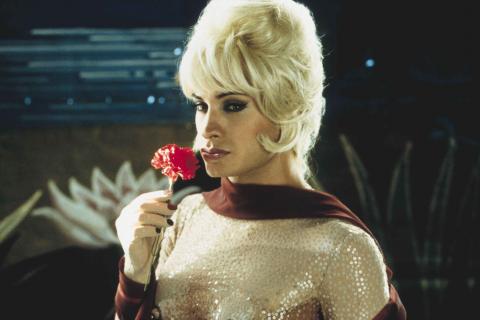Cinema as Labyrinth: Almodóvar's BAD EDUCATION

BAD EDUCATION (LA MALA EDUCACIÓN)
These notes on Pedro Almodóvar Bad Education were written by Matt Connolly, PhD candidate in UW Madison’s Department of Communication Arts. A 35mm print of Bad Education will screen in our ongoing Sunday Cineamtheque at the Chazen series devoted to Almodóvar on November 12 at 2 p.m.
By Matt Connolly
With their luscious color palettes, twisting narratives, and bold genre revisionism, the films of Pedro Almodóvar embody full-throated cinephilia in both their formal richness and their knowing nods to movie history. For all his explicit cinematic citations, though, Almodóvar can take a strikingly equivocal stance on the role of film in the lives and dreams of his characters. Bad Education stands as one of the director’s most ambivalent meditations on the powers and perils of the moving image.
We are first introduced to director Enrique (Fele Martínez) scrounging for new film ideas in the local tabloids. In the midst of this artistic stagnation, he receives an unexpected visit from Ignacio (Gael García Bernal), an old friend from Catholic boarding school and Enrique’s first love. Ignacio is an aspiring actor now going by Ángel, and he brings along a short story he wrote based on their shared childhood that he hopes Enrique will adapt for the screen (with Ángel in the lead role). Entitled “The Visit,” the story envisions an alternative reunion between the two men. Ignacio (also Bernal) is portrayed here as a trans performer and junkie named Zahara who hopes to reignite her adolescent relationship with Enrique. To obtain the money to complete her sexual-reassignment surgery, Zahara returns to her childhood Catholic school and visits Father Manolo (Daniel Giménez Cacho). She slips him a story she has written entitled (you guessed it) “The Visit.” In it, we finally see Ignacio and Enrique’s childhood romance and how it was broken apart by the sexual predations of Manolo. Zahara demands cash for her surgeries in exchange for her continued silence on Manolo’s past abuses. Eventually returning to the original frame story, Enrique agrees to adapt and direct “The Visit” as his next project, but almost immediately begins to question the true identity and motives of Ángel.
Bad Education shuttles effortlessly between these three stories-within-stories within its first half. That Almodóvar pushes his narrative gamesmanship to at-times head-spinning limits while retaining a legible emotional through line speaks to both his exquisite formal control and the nuance of his central performers. There’s a delicious interplay within Almodóvar’s later films between the riotous hues of his mise-en-scene and the restraint of his cinematography. Such a dynamic structures many of Bad Education’s most memorable scenes, with the brazen colors and pitched emotions set before the camera captured via fastidiously composed static framings and subtly creeping tracking shots. His cast, meanwhile, elegantly delivers the film’s cascade of plot revelations and emotional reversals. First among equals is Bernal, who is tasked not only with portraying (at least) two versions of the same character, but unmasking a core of genuine pain even as Ignacio’s true identity becomes evermore clouded in suspicion.
Indeed, as the film-within-a-film finally gets underway in Bad Education’s second half, art’s would-be transformative power proves inadequate in the face of the true story behind Ignacio’s past and present. Without disclosing the twists that make Bad Education’s final movement so powerful, it’s fair to say that both Enrique and Ángel enter into the film’s production with divergent but equally vivid hopes—the former to rekindle lost childhood relationship; the latter to transform private demons into professional opportunities. Film figures centrally in their previous romance, with their first moment of intimacy occurring in the semi-private sanctuary of the local picture palace. As adults, however, their director-actor relationship becomes increasingly riddled with deception and coercion. And when it seems as if Ángel has found a kind of emotional catharsis in front of the camera, a shadowy figure from the past enters the set and provides the film’s final series of epiphanies. What Ángel has written and Enrique has filmed ends up proving but a pale imitation of the anguished cycle of trauma that is Ignacio’s true history and destiny.
It’s a piquant irony, of course, that Almodóvar can so dexterously use the cinematic form in the service of a story that pointedly reveals its limits. His sumptuous images, agile narration, and tough-minded empathy illuminate the inner lives of even the most odious of his characters, achieving the very insights that Enrique and Ángel search for. This tension forms the bruised heart of Bad Education, making it amongst Almodóvar’s bleakest yet most invigorating works. This is cinema as labyrinth—a flickering maze of elusive images and shifting identities in which its characters seek salvation but only find delusion, despair, death.
